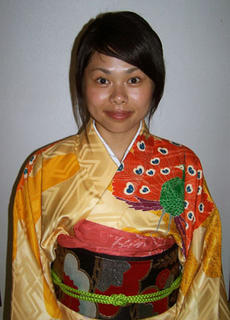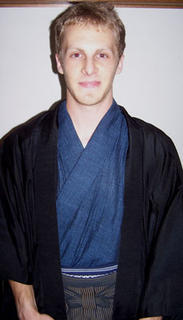Kimono Lessons
So I think I mentioned in an earlier post that Anna and I are taking lessons (for free!) in how to wear a kimono. There are many types of kimono for women, and the style Anna is learning to wear is called a furisode (振袖). This shows up as "long-sleeved kimono" in my dictionary, but the etymology is more like "wave-sleeve." Evidently young single women in Japan used to wear this type of kimono, climb a mountain and wave the sleeves around, trying to attract single men to come court them. Furisode (roughly like "who-re[run]-sew-day") tend to have bright, vibrant colors. Along with the kimono itself, Anna is learning how to tie an obi (帯), or "kimono sash," in a style called fukura-suzume (脹雀・福良雀), which literally translates as "plump swallow." The first kanji compound is the more traditional way of writing it, and the second seems to be a play on words, having the same reading but using two kanji meaning "luck" and "good" instead of one meaning "plump" for the fukura portion of the word. Sorry to everybody reading who is not a student of Japanese...these explanations must make my writing really inaccessible. Please indulge my long-winded explanations, as I am writing this blog as much to support my horrible memory as to share my stories about life in Japan.
Anyway, that's what Anna's learning, and I'm learning how to wear a men's kimono, consisting of a kimono, hakama (man's formal divided skirt), and haori (formal coat). I have it a lot easier, because it's awfully complicated for women, but not too bad for men.
I decided to post some pictures of us and our friend Yoko, who is taking lessons with us, so enjoy!
The intricate and lovely part of the fukura-suzume obi is in back, as you may know, and unfortunately I don't have any pictures of that yet, but will try to post some next Sunday after our next lesson.
Anyway, that's what Anna's learning, and I'm learning how to wear a men's kimono, consisting of a kimono, hakama (man's formal divided skirt), and haori (formal coat). I have it a lot easier, because it's awfully complicated for women, but not too bad for men.
I decided to post some pictures of us and our friend Yoko, who is taking lessons with us, so enjoy!
The intricate and lovely part of the fukura-suzume obi is in back, as you may know, and unfortunately I don't have any pictures of that yet, but will try to post some next Sunday after our next lesson.




